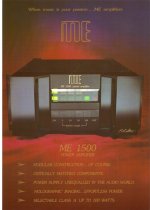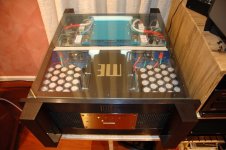Ehm no? Not even close?But if you take an average of all "common" ones (esl's etc exculded), they "kinda" follow a similar to a degree impedance curve
Cheers George
Even less so when you take the passive filter in mind.
For years as far as I can remember global negative feedback in an amp was always better off if it didn't "have" to be used too much if all else was worked out well.Its better and simpler to use an amp that is linear in all loads.
//
If in these two amps it's digital all the way to the output stage with DSP, why not utilize the DSP in it to it's full potential? And have it do a "speaker impedance calibration setup" to follow that speaker that's it's being used on. (that way global negative feedback to control the output stage can take a hike)👍
Cheers George
Last edited:
9 pages and no subjective listening impressions...
Now there is one (or two) on sale now out there on the resale 'net 😉
Now there is one (or two) on sale now out there on the resale 'net 😉
Was it really now.... or was it that the rest of the systems was so dull and boring and dead that a little extra sugar didn't hurt?For years as far as I can remember global negative feedback in an amp was always better off if
//
or was it that the rest of the systems was so dull and boring and dead that a little extra sugar didn't hurt?
That would be a big no!! if you quoted the rest of my sentance instead of leaving the important bit out!
If you listen to this amp and all his amps with no global FB, 220 damping factor with just a little front end local FB, you'd change your mind big time on that one. (RIP Peter Stein)
Cheers George
Attachments
Last edited:
Most old sh*t is coloured compared to modern amps.
This of course OK but "advertise" it as better...??
//
This of course OK but "advertise" it as better...??
//
OK you don't listen, or haven't done the listening test. It has a damping factor of 220 still with just local feedbackThis of course OK but "advertise" it as better...??
I had the listening choice when he demo'd it with "just local" and "with global".
It was no contest for "local" was the clear winner, the music left the confines of speaker like they didn't need to be there, the global did not it sounded pinched and emmited from the drivers, not just with your ear, but your eyes too.
This was done in a very small old local sand stone church hall of around 20 listeners through a pair of impressive sounding Infinity IRS Delta Gamma speakers.
Really! you have no idea, you think you can hear the difference between .05% and .005% distortion or DF of 220 compare to 2000 on speakers that have over 2% to 5% distortion, get real! go pat a polar bear.Most old sh*t is coloured compared to modern amps.
Cheers George
Last edited:
Well, for one who dont know if an amp is class-d or not, I will not take any technical lesson from... sorry. Posting Darko YT videos as a creditable source don't help either. And why did you refer to the distortion figure in your initial post if you don't think it matters; "Really! you have no idea, you think you can hear the difference between .05% and .005% distortion")?
//
//
For the ones that believe only todays amps aren't coloured.
If an amp has an 8ohm damping factor of 220, that means it has an ouput impedance of approx .036 yay or nay??
And if driving a speaker load that varies between 3 to 10ohms will it behave like a tone control? if so, by how many dB will it deviate from dead flat??
Cheers George
If an amp has an 8ohm damping factor of 220, that means it has an ouput impedance of approx .036 yay or nay??
And if driving a speaker load that varies between 3 to 10ohms will it behave like a tone control? if so, by how many dB will it deviate from dead flat??
Cheers George
Rather than retype a lot of what seems to be known, I think the team at Benchmark did a nice summary.
https://benchmarkmedia.com/blogs/application_notes/audio-myth-damping-factor-isnt-much-of-a-factor
https://benchmarkmedia.com/blogs/application_notes/audio-myth-damping-factor-isnt-much-of-a-factor
👍Rather than retype a lot of what seems to be known, I think the team at Benchmark did a nice summary.
As thought, the Benchmark damping factor calculations, if you believe them, are with the 220 damping factor of the linear amp I posted above without negative feedback just a bit of frontend local used on the Focal 826 speaker (quite a hard load), varied from a flat frequency response by only .17dB, which is undecectable in a normal listening room!
Cheers George
I have to wonder, as you press those Class A radio buttons on up to 100, does this amp's power supply begin humming louder with each increase? Maybe it's a switcher, but I doubt it ;')the linear amp I posted above
It's no switcher, but if your very close with you ear to it, at 100w class-A very slight tranny noise, remember it's massive 5kva tranny.I have to wonder, as you press those Class A radio buttons on up to 100, does this amp's power supply begin humming louder with each increase? Maybe it's a switcher, but I doubt it ;')
The fans are speed controlled and just detectable at 100w class-a in-between tracks, but not from the listening seat.
Cheers George
Little bit about the cooling of this. As said the fans are heatsink temp speed controlled. And usually just kick over at 30w Class-A settting.
The air intakes are behind the massive chamfered front handels, you can just see the grill then foam filters (user cleanable) behind them, with very quiet German made fans behide them sucking air in from the front grills.
The the two channels are East/West with their heatsinks butted together to form a chimney heatsink, with fins on the inside "perfect", then the exhaust is at the rear and you can see the two butted heat sinks through the grill.
Those 92 x cap banks are "tripple stacked" in height. Purposely done that way (instead of big baked bean cans) to keep the power supplies series resistance (ESR) very low.
Cheers George
This pic is of the similar but cheaper ME1400 which has set 10w Class-A bias, no adjustments on the front.
The air intakes are behind the massive chamfered front handels, you can just see the grill then foam filters (user cleanable) behind them, with very quiet German made fans behide them sucking air in from the front grills.
The the two channels are East/West with their heatsinks butted together to form a chimney heatsink, with fins on the inside "perfect", then the exhaust is at the rear and you can see the two butted heat sinks through the grill.
Those 92 x cap banks are "tripple stacked" in height. Purposely done that way (instead of big baked bean cans) to keep the power supplies series resistance (ESR) very low.
Cheers George
This pic is of the similar but cheaper ME1400 which has set 10w Class-A bias, no adjustments on the front.
Attachments
Last edited:
😉
Did you really expect anything else from someone with so much to loose with a relatively new Purifi company.
Since Purifi's have just started to make some little inroad over Hypex, the last thing he wants now is this GaN technology to cause buyers to "think twice" before buying either Purifi or Hypex, and saying to themselves let's see what happens and where GaN goes.
Did you really expect anything else from someone with so much to loose with a relatively new Purifi company.
Since Purifi's have just started to make some little inroad over Hypex, the last thing he wants now is this GaN technology to cause buyers to "think twice" before buying either Purifi or Hypex, and saying to themselves let's see what happens and where GaN goes.
Or flip it. If GaN had any advantage he would be using it.
- Status
- Not open for further replies.
- Home
- Amplifiers
- Class D
- Peachtree new GaN-1 all "Digital Amplifier" the future?? (and it's not Class-D)


